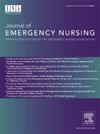使用行为评估工具减少急诊室使用限制措施的情况。
IF 2.3
4区 医学
Q2 EMERGENCY MEDICINE
引用次数: 0
摘要
导言:到急诊科就诊的行为健康患者越来越多,这增加了患者暴力躁动的风险,可能需要使用束缚措施来控制。我们的目标是确定使用行为活动评分量表和与患者评分相匹配的治疗建议是否会影响急诊科住院期间需要使用束缚措施的患者人数:在这个质量改进项目中,护理人员对急诊科的所有行为健康患者进行了行为活动评分量表评估,评估在分诊过程中进行,并与生命体征一起定期进行。在实施前收集了一段时间的数据,并与实施行为活动分级量表工作流程后收集的数据进行了比较。对住院期间需要使用束缚措施的患者、住院期间需要使用 2 次或 2 次以上束缚措施的患者以及使用束缚措施的时间进行了分析:结果显示,在急诊室住院期间需要使用限制措施的患者人数有所减少,从 8.7% 降至 7.0%(P = .02)。需要使用多重束缚措施的患者人数也有所减少,从 82.2% 降至 27.2% (P < .001)。干预前后,到达医院 1 小时后需要使用束缚措施的患者人数没有差异(P = .40):讨论:及早识别病人的躁动对适当治疗躁动至关重要。行为活动量表评估是量化患者躁动程度的有效工具。如果与治疗建议或方案相结合,它可以减少急诊科使用束缚措施的情况。本文章由计算机程序翻译,如有差异,请以英文原文为准。
Using a Behavior Assessment Tool to Decrease Restraint Use in the Emergency Department
Introduction
Behavioral health visits to emergency departments have increased, increasing the risk of patient violent agitation that may require restraints to control. Our objective was to determine whether using the Behavioral Activity Rating Scale and treatment recommendations matched to patient scores would affect the number of patients who required physical restraints during their stay in the emergency department.
Methods
In this quality improvement project, nursing performed Behavioral Activity Rating Scale assessments on all behavioral health patients who presented to the emergency department, occurring during triage and at regular intervals with vital signs. Data were collected for a period before implementation and compared with data collected after implementing the Behavioral Activity Rating Scale workflow. Patients who required restraints during their stay, patients who required 2 or more restraints during their stay, and timing of restraint application were analyzed.
Results
Results show a decrease in the number of patients who required restraints during their ED stay, decreasing from a rate of 8.7% to 7.0% (P = .02). There was also a decrease in the number of patients who required multiple restraints, from a rate of 82.2% to 27.2% (P < .001). There was no difference in the number of patients who required restraints 1 hour after their arrival before versus after intervention (P = .40).
Discussion
Early recognition of patient agitation is essential in appropriate treatment of that agitation. The Behavioral Activity Rating Scale assessment is an effective tool to quantify a patient’s agitation level. When coupled with treatment recommendations or protocols, it may decrease restraint use in the emergency department.
求助全文
通过发布文献求助,成功后即可免费获取论文全文。
去求助
来源期刊
CiteScore
3.10
自引率
11.80%
发文量
132
审稿时长
46 days
期刊介绍:
The Journal of Emergency Nursing, the official journal of the Emergency Nurses Association (ENA), is committed to the dissemination of high quality, peer-reviewed manuscripts relevant to all areas of emergency nursing practice across the lifespan. Journal content includes clinical topics, integrative or systematic literature reviews, research, and practice improvement initiatives that provide emergency nurses globally with implications for translation of new knowledge into practice.
The Journal also includes focused sections such as case studies, pharmacology/toxicology, injury prevention, trauma, triage, quality and safety, pediatrics and geriatrics.
The Journal aims to mirror the goal of ENA to promote: community, governance and leadership, knowledge, quality and safety, and advocacy.

 求助内容:
求助内容: 应助结果提醒方式:
应助结果提醒方式:


